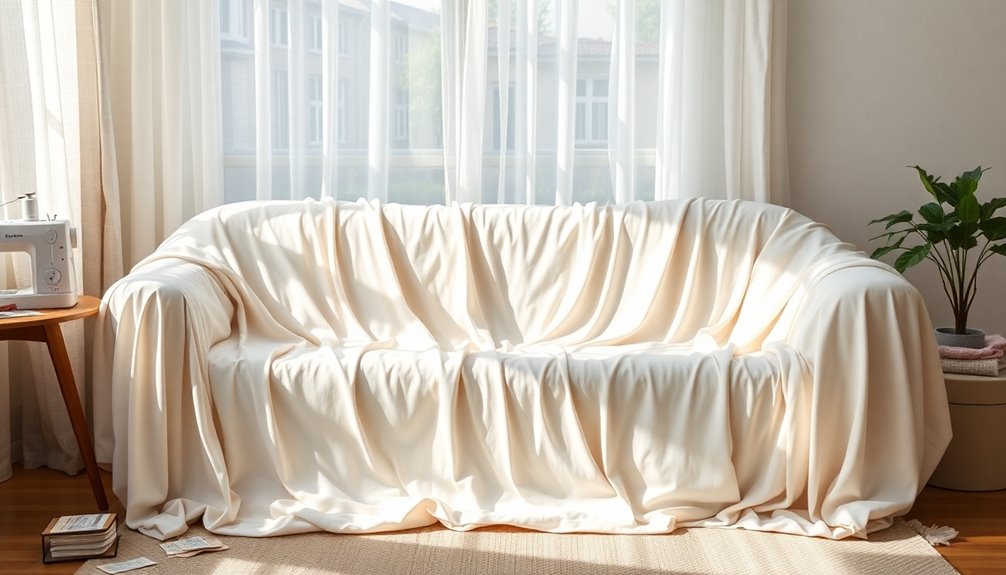You can easily make stylish sofa covers from sheets in just a few steps. Start by measuring your sofa and choosing sheets that fit well. Lay the sheets flat over the couch, tucking them neatly into the cushions to keep everything in place. Use fabric clips or safety pins for a tighter fit. If you want to personalize your covers, consider adding fabric paint or removable adhesive designs. Lastly, remember to wash the sheets regularly for maintenance. There's plenty more to explore about creating unique sofas that suit your style perfectly.
Key Takeaways
- Measure your sofa dimensions accurately to determine the amount of fabric needed for the covers.
- Choose sheets with patterns or colors that match your personal style and home decor.
- Use fabric scissors to cut sheets according to the measured dimensions, allowing extra for seams.
- Sew the edges or use fabric adhesive to prevent fraying and secure the sheets in place.
- Consider adding ties or elastic to keep the covers snugly fitted on the sofa.
Introduction
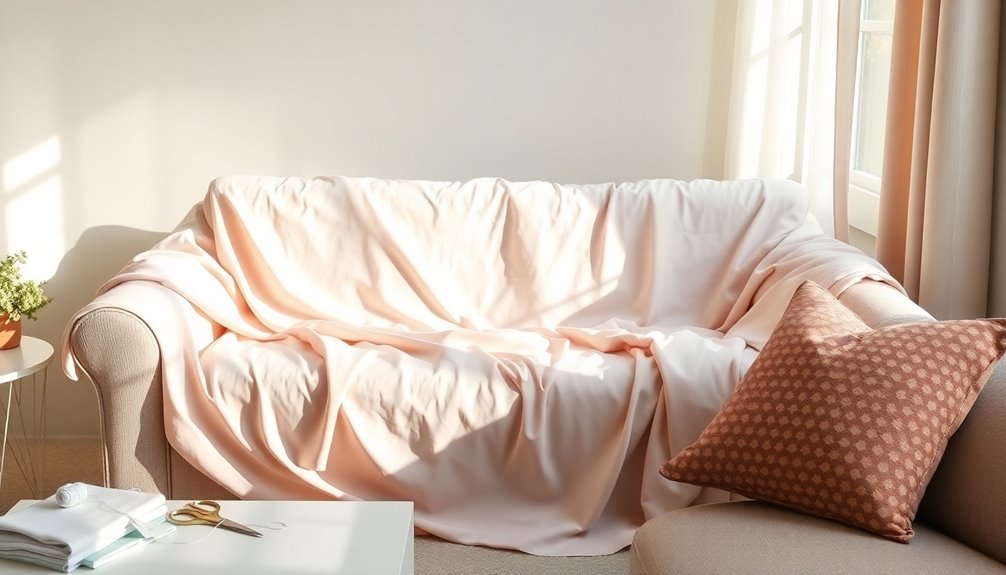
When it comes to keeping your new sofa covers looking fresh, routine vacuuming and spot-cleaning should be your go-to strategies. Different fabrics require specific cleaning techniques, so knowing what works best can save you time and effort. And if you happen to spill wine, there are effective ways to tackle that too, ensuring your covers stay in top shape.
Routine Vacuuming and Spot-Cleaning
To keep your sofa covers looking fresh and clean, routine vacuuming and spot-cleaning are essential practices. Regular vacuuming helps remove dust, pet hair, and allergens that can accumulate on your sheets. Use a soft brush attachment to lift debris without damaging the fabric, ensuring your sofa covers maintain their appearance. Aim to vacuum at least once a week, especially if you have pets or children, to minimize dirt buildup.
When spills occur, act quickly with spot-cleaning. Mix a mild detergent with water and dab the affected area gently to prevent stains from setting in. This quick action can significantly extend the life of your sofa covers. For deeper cleaning, consider machine washing your sheet covers according to the care instructions. This refreshes the fabric and removes odors, typically recommended every 1-3 months based on usage.
Fabric-Specific Cleaning Techniques
Understanding the specific cleaning techniques for different fabric types can significantly enhance the longevity and appearance of your sofa covers. If you're using cotton sheets for your couch cover, you'll find they're generally machine washable in cold water and can be tumble dried on low heat. This method helps prevent shrinkage and keeps your covers looking fresh. For linen sheets, it's best to wash in cold water and either air dry or tumble dry on low to maintain the fabric's integrity and prevent wrinkles.
If you opt for polyester or synthetic sheets, wash them in warm water and dry on low heat to avoid damaging the fibers and reduce static build-up. When washing darker sheets, always do so with like colors and add a cup of white vinegar to prevent color fading over time.
For stubborn stains on any fabric, remember to pre-treat with a gentle detergent or a stain remover before washing. Just be sure to test it on a hidden area first to avoid discoloration. Following these cleaning techniques will keep your sofa covers looking great for years to come.
Tackling Wine Spills Effectively
Even the best sofa covers can fall victim to unexpected mishaps, like wine spills. When that happens, it's crucial to act quickly to protect your couch's upholstery. Start by grabbing a clean cloth or paper towel to blot the spill. Make sure you're absorbing as much liquid as possible without rubbing, which can spread the stain further.
Next, create an effective cleaning solution by mixing one part dish soap, one part white vinegar, and two parts water. Apply this solution to the stained area using another clean cloth, working from the outside of the stain towards the center. This technique helps contain the spill and prevents it from spreading.
After treating the stain, rinse the area with cold water and blot again with a dry cloth to remove any excess moisture and the remaining solution. If you're dealing with a stubborn stain, don't hesitate to use a commercial upholstery cleaner that's safe for your slipcovers, following the manufacturer's instructions.
Furniture Polish Application Tips
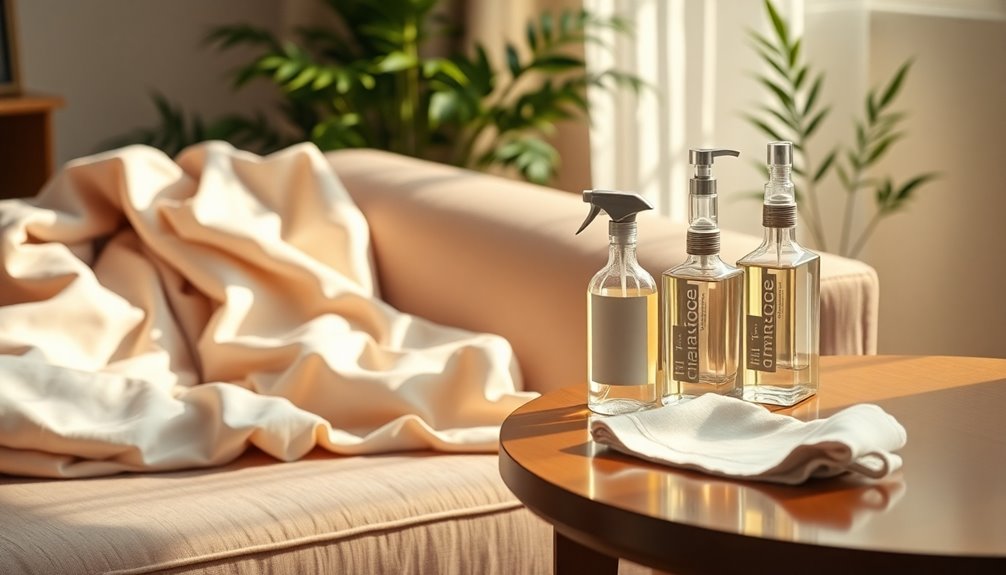
When you're ready to polish your furniture, start by choosing a scratch-resistant fabric to protect your surfaces. Layering your polish can provide added protection, while reinforcing seams ensures durability. These steps help maintain your furniture's appearance and prolong its life.
Scratch-Resistant Fabric Selection
Choosing the right fabric for your sofa is essential if you want to keep it looking great amidst daily wear and tear. Opt for scratch-resistant materials like microfiber or canvas, which can withstand the claws of pets and daily use. These fabrics not only provide comfort but also enhance your sofa's durability.
To further protect your investment, apply a furniture polish specifically designed for fabric. This will create a protective barrier that helps repel dirt and stains, ensuring your sofa remains pristine. Just remember to regularly reapply the polish according to the manufacturer's instructions to maintain its effectiveness.
If you're looking for an extra layer of protection, consider using slipcovers made from high-denier polyester or nylon. These materials offer increased durability against scratches and abrasions, making them an excellent choice for high-traffic areas. Additionally, using sustainable practices can help reduce the environmental impact of materials used in upholstery. Before applying any furniture polish, it's wise to test it on a small, hidden area of the fabric first to ensure compatibility and avoid discoloration. By selecting the right scratch-resistant fabric and using furniture polish correctly, you can keep your sofa looking new for years to come.
Layering for Added Protection
To maintain the longevity and appearance of your sofa covers, applying furniture polish correctly is crucial. Start by ensuring your fitted sheets are clean and free of dust, as any dirt can get trapped during the polishing process. Use a microfiber cloth for application; it effectively lifts dust and grime while minimizing the risk of fabric damage.
Before diving in, test the polish on a small, inconspicuous area of the sheet cover to check for fabric compatibility and avoid any discoloration or staining. Once that's done, apply the polish in sections, using gentle circular motions to work it into the fabric. Allow it to absorb for a few minutes before buffing it with a clean cloth.
Regular polishing not only enhances the appearance of your sofa covers but also provides that essential layering for added protection against spills and stains. This simple step is key to prolonging the lifespan of your covers, keeping them looking fresh and new. By following these tips, you'll ensure your sofa covers made from sheets stay beautiful and functional for years to come.
Reinforcing Seams for Durability
Over time, the seams of your sofa covers can experience wear and tear, making it essential to reinforce them for durability. Start by using a sewing machine to stitch seams with a straight stitch. To prevent fraying, follow up with a zigzag stitch, which enhances the longevity of your slipcover. For added strength, opt for a heavier-weight thread designed specifically for upholstery projects. This type of thread can withstand the daily wear and tear better than standard options.
When working on high-stress areas like arm covers, be sure to double-stitch the seams. This extra reinforcement helps maintain the integrity of your slipcover, ensuring it holds up over time. Regularly inspect your seams after washing and tighten any loose areas, as fabric can stretch and shift.
After completing your slipcover, it's a good idea to apply a fabric protector spray. This creates a barrier against spills and stains, further reinforcing the fabric's durability. By taking these steps, you'll ensure that your sofa covers not only look great but also last longer, providing you with reliable protection for your furniture. Additionally, consider implementing safety precautions to avoid potential hazards when dealing with fabric treatments and sewing equipment.
Cushion Foam Replacement Techniques
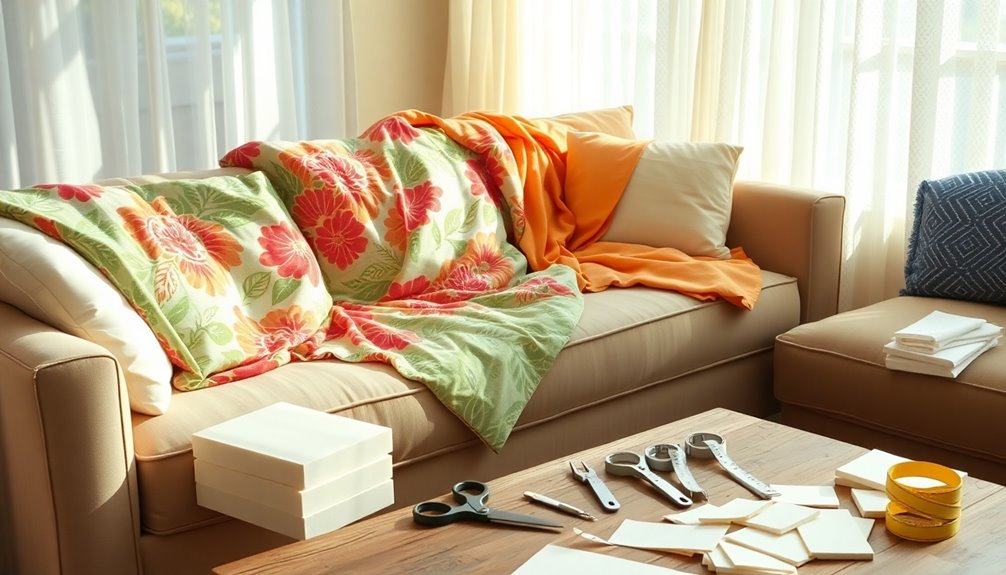
When you're replacing cushion foam, it's crucial to prevent sagging by choosing high-resilience options that last longer. You might also want to think about leather conditioning treatments to keep your sofa looking great alongside your new cushions. Revitalizing your couch cushions can make a huge difference in comfort and style, so let's explore some effective techniques.
Cushion Sagging Prevention Methods
Preventing cushion sagging starts with the right foam replacement techniques. Begin by replacing old foam with high-density foam, which provides better support and durability compared to standard options. Use a measuring tape to ensure your new foam pieces match the dimensions of the existing cushions for a snug fit. Look for foam with an ILD (Indentation Load Deflection) rating of at least 35; this rating indicates firmness, helping to resist sagging over time. To enhance comfort and maintain shape, consider adding a layer of batting over the foam. This extra layer not only increases softness but also contributes to the overall durability of your cushions. Regularly fluff and rotate your cushions to promote even wear distribution, which can significantly prolong their life and help mitigate the effects of cushion sagging. Additionally, using high-efficiency ratings in your foam choice can further support durability and comfort.
Leather Conditioning Treatment
Maintaining your leather sofa goes hand-in-hand with ensuring your cushions are in top shape. Start by applying a high-quality leather conditioner every few months to keep the leather supple and prevent it from cracking. This treatment not only enhances the appearance of your sofa but also protects against stains and spills, contributing to its longevity.
When it's time to replace your cushion foam, measure the existing foam's thickness and dimensions to ensure a snug fit in your cushion covers. Opt for high-density foam for the best support and durability; it can last between 5 to 10 years with proper care. For added comfort, consider a combination of different foam types—like a softer top layer for a plush feel and a firmer base for support.
After you've replaced the foam, use fitted sheets as DIY covers to protect your new cushions. Regular cleaning of both the sofa and cushions helps maintain their quality. By following these tips, you'll enhance the comfort of your leather sofa while ensuring it looks great for years to come.
Revitalize Your Couch Cushions
Revitalizing your couch cushions can breathe new life into your entire living space, making it feel fresh and inviting again. One effective way to achieve this is by replacing old foam cushions with high-density options. These not only enhance comfort but also improve durability and support. Start by accurately measuring your existing cushion dimensions, as foam typically comes in thicknesses ranging from 2 to 8 inches.
Choose the type of foam based on your comfort preference—memory foam offers a softer feel, while firm foam provides more support. Once you've selected your foam, consider adding a fabric cover for a personalized touch. You can easily create a fitted sheet or flat sheet fabric cover that matches your aesthetic appeal, allowing you to customize your sofa's look. Additionally, incorporating smart home device integration can enhance your overall living experience by seamlessly controlling lighting and temperature in your refreshed space.
Regularly replacing worn-out foam cushions prolongs your sofa's lifespan and keeps it looking great. Plus, using washable fabric covers makes maintenance a breeze. With these simple steps, you'll transform your cushions into durable, stylish pieces that enhance the overall vibe of your living area. So, get ready to enjoy a refreshed and cozy space!
Personalized Fabric Patterns
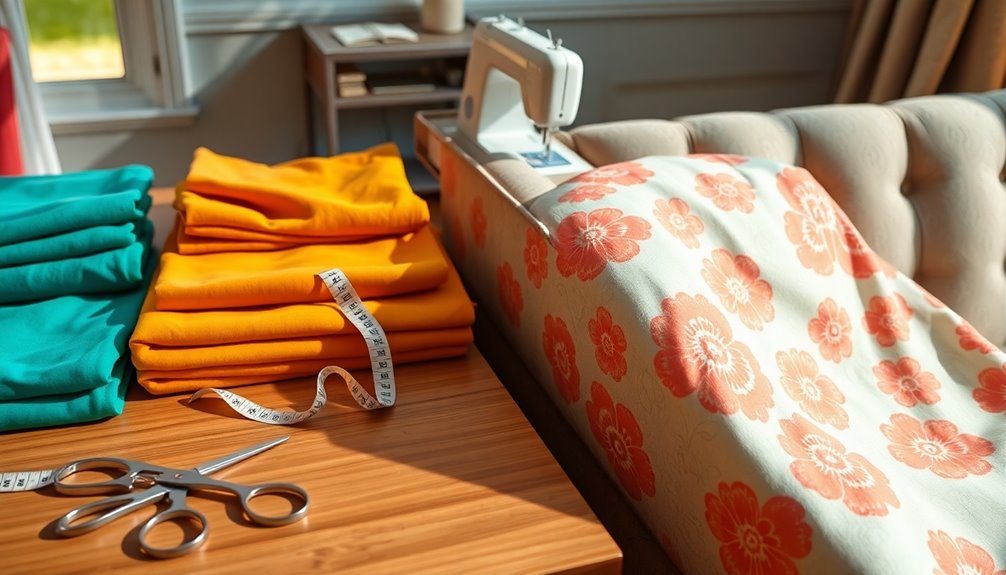
When it comes to making sofa covers, personalized fabric patterns can transform your living space into a reflection of your unique style. Start by choosing fabric sheets that showcase your personality—think florals, geometric designs, or solid colors that resonate with you. If you can’t find exactly what you want, consider using fabric paint or dye to customize plain sheets, allowing for creativity in colors and designs. Additionally, incorporating various textures and layering different patterns can add depth and visual interest to your sofa. For those who want to take their personalization a step further, exploring sofa dyeing techniques for nonremovable fabrics can breathe new life into older pieces. With the right approach, you can achieve a customized look that perfectly complements your interior design, making your sofa the centerpiece of your living area.
Thrift stores and fabric shops often have unique patterned sheets that can serve as eye-catching covers without breaking the bank. These finds can add a special touch to your decor. To enhance your covers further, utilize removable fabric adhesive or iron-on transfers to add personalized motifs or images, giving your sofa a custom touch.
Lastly, don't forget to incorporate seasonal patterns or colors. This way, you can easily update your sofa covers throughout the year, keeping your home decor fresh with minimal effort. By focusing on personalized fabric patterns, you create a unique and inviting atmosphere that reflects your style and creativity.
Seasonal Fabric Storage Tips
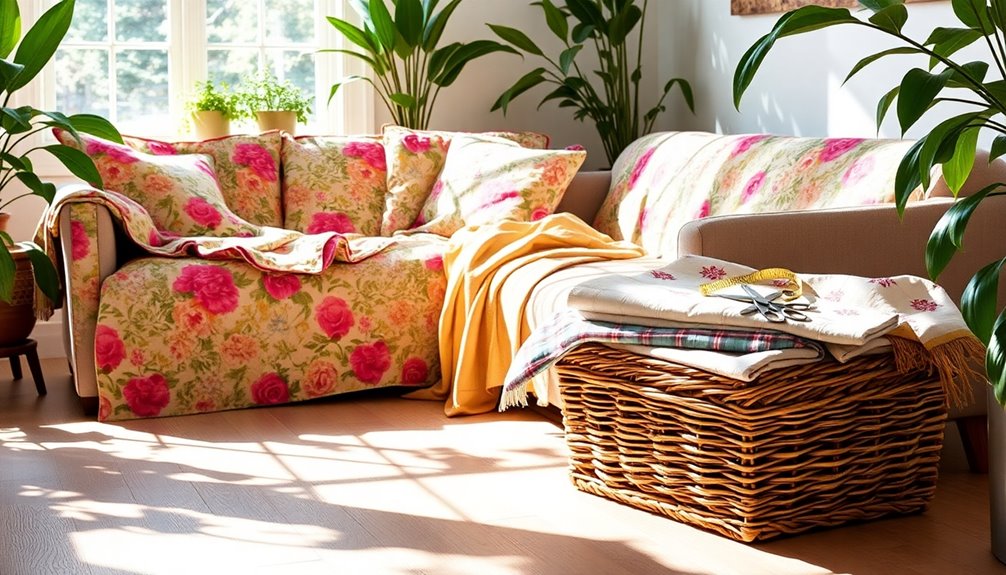
After you've chosen your personalized fabric patterns for your sofa covers, it's important to think about how to store them when the seasons change. For effective seasonal fabric storage, start by using breathable cotton bags to prevent moisture buildup, which helps preserve fabric integrity. If you have delicate fabrics, wrap them in acid-free tissue paper to protect against creases and maintain their shape while stored.
Label your storage bins or bags clearly to reduce time searching for specific covers when the next season rolls around. This simple step saves you hassle and keeps your organization on point. Make sure to keep your fabric covers away from direct sunlight to prevent fading and discoloration, ensuring they remain vibrant for future use.
For added protection, consider using vacuum-sealed bags. They save space while safeguarding your fabrics from dust, pests, and humidity, which can extend the life of your covers significantly. By following these tips, you'll keep your seasonal sofa covers in top condition, ready for a quick switch when you want to refresh your living space.
Conclusion

Creating your own sofa covers can be a rewarding and practical project that breathes new life into your living space. By using fitted sheets, you can easily customize your sofa covers to reflect your personal style and match your existing home decor. This DIY approach not only allows for cost-effective solutions—averaging around $29—but also offers the flexibility to change designs seasonally.
The process is straightforward: measure your couch, cut the sheets, and use safety pins for a snug fit, all without needing professional help. Plus, regular washing of these sheets ensures cleanliness and protects your original upholstery from spills and stains, making it especially pet-friendly for homes with kids or furry friends.
Incorporating seasonal designs means you can switch out your sofa covers whenever you like, creating an ever-evolving aesthetic in your living area. Overall, making your own sofa covers from sheets is a fantastic way to enhance your home decor, ensure upholstery protection, and express your creativity through easy customization. So grab those sheets and get started on this fun, cost-effective project!
Frequently Asked Questions
Can I Use a Bedsheet as a Sofa Cover?
Absolutely, you can use a bedsheet as a sofa cover! It's a cost-effective and creative way to protect your furniture while adding a splash of color or pattern. A queen or full-sized sheet usually fits a standard seven-foot couch nicely, letting you tuck in the excess for a snug look. Plus, fitted sheets work wonders for keeping everything in place. They're easy to clean too, making them perfect for homes with kids or pets!
How to Use a Sheet as a Couch Cover?
To use a sheet as a couch cover, start by choosing a sheet that fits your couch size. Remove the cushions and vacuum the area for a clean start. Drape the sheet evenly over the couch, leaving extra fabric to tuck in for a snug fit. Tuck the sheet into any crevices for a tailored look, and use safety pins or fabric clips to secure it in place. Enjoy your refreshed couch!
How to Turn a Blanket Into a Couch Cover?
To turn a blanket into a couch cover, you'll want to pick a blanket large enough to drape over your sofa completely. Lay it flat, ensuring it covers all sides evenly. Tuck the edges into the crevices for a snug fit. If needed, secure it with safety pins or fabric clips. For added stability, consider sewing a pocket or hem at the edges. Remember to wash it regularly to keep it looking fresh!
How Can I Cover My Couch Without a Couch Cover?
You can easily cover your couch without a traditional couch cover by using flat or fitted sheets. Just drape the sheets over your couch and tuck them into the crevices for a snug fit. If you want a secure look, use safety pins or fabric clips to hold everything in place. For a tailored appearance, measure your couch and cut the sheets accordingly. Swap out colors seasonally for a fresh update to your decor!
